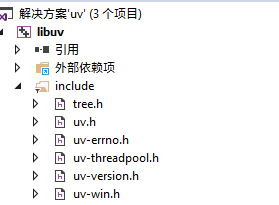libuv 一 环境搭建, hello TTY
引言 - 一时心起, libuv linux 搭建
有一天突然想起来想写个动画. 找了一下 ui 库太大. 后面想起以前弄过的 libuv. 但发现 libuv 相关资料也很少.
所以就有了这些内容.
libuv - https://github.com/libuv/libuv
libuv 在 linux 上面使用比较简单, 一开始 从 linux hello 跑起来
libuv linux 安装
首先假定你和我一样用的是Ubuntu去做开发. 在云平台上面测试过, Ubuntu Server 版本比 CentOS 版本少个十几兆.
有兴趣朋友可以详细比较数据, 也可以尝试跑跑 Ubuntu Server .
# libuv 安装 cd wget https://github.com/libuv/libuv/archive/v1.18.0.tar.gz tar -zxvf v1.18.0.tar.gz cd libuv-1.18.0 sh autogen.sh ./configure make -j4 sudo make install sudo ldconfig cd ../ rm -rf libuv-1.18.0 v1.18.0.tar.gz ```
执行上面命令操作, 我们的系统中就已经有了 libuv 开发环境.
有一点需要注意的是当我们要使用 libuv时候推荐用静态库.
gcc -l:libuv.a
到这里 linux 安装 libuv 已经完工了.
不妨写个 hello world demo
#include <uv.h> #include <assext.h> // // 测试 libuv tty 操作控制台 // 输出一段有颜色的文字 // void uv_tty_test(void) { uv_tty_t tty; uv_buf_t buf[3]; unsigned i, len = sizeof buf / sizeof *buf; uv_loop_t * loop = uv_default_loop(); // 目前只对 tty 控制台处理 if (uv_guess_handle(1) != UV_TTY) { fprintf(stderr, "uv_guess_handle(1) != UV_TTY!\n"); exit(EXIT_FAILURE); } uv_tty_init(loop, &tty, 1, 0); uv_tty_set_mode(&tty, UV_TTY_MODE_NORMAL); // 开始发送消息 buf[0].base = "\033[46;37m"; buf[1].base = u8"(✿◡‿◡) 喵酱 ((●'-'●)) 比 ♥ 里~ \n"; buf[2].base = "\033[0m"; for (i = 0; i < len; ++i) buf[i].len = (int)strlen(buf[i].base); uv_try_write((uv_stream_t *)&tty, buf, len); // 重置终端行为 uv_tty_reset_mode(); uv_run(loop, UV_RUN_DEFAULT); }
代码运行效果是, 输出一段话, 并且设置背景色. 对于 uv_tty_test 可以理解为 main (本质是 structc 一种单元测试函数约束写法)
到这容我安利一个小东西, 感兴趣的可以尝试一下, 从零开始搭建一个 c 的 struct 小框架. 五脏逐渐全了.
structc - https://github.com/wangzhione/structc
简单说一下libuv中使用的几个函数, 第一个是 uv_try_write 尝试立即发送消息数组. 不像 uv_write 写入到消息队列中.
int uv_try_write(uv_stream_t* handle, const uv_buf_t bufs[], unsigned int nbufs)
Same as uv_write(), but won’t queue a write request if it can’t be completed immediately. Will return either: > 0: number of bytes written (can be less than the supplied buffer size). < 0: negative error code (UV_EAGAIN is returned if no data can be sent immediately).
目前我们是用 tty 输出到屏幕上面, 可以用这个 api . 如果单纯是走 TCP, 不要过于依赖这个 api.
说白了为了稳定性还是别用 uv_try_write.
第二个要说的是 uv_run
int uv_run(uv_loop_t* loop, uv_run_mode mode) This function runs the event loop. It will act differently depending on the specified mode: UV_RUN_DEFAULT: Runs the event loop until there are no more active and referenced handles or requests.
Returns non-zero if uv_stop() was called and there are still active handles or requests.
Returns zero in all other cases. UV_RUN_ONCE: Poll for i/o once. Note that this function blocks if there are no pending callbacks.
Returns zero when done (no active handles or requests left),
or non-zero if more callbacks are expected
(meaning you should run the event loop again sometime in the future). UV_RUN_NOWAIT: Poll for i/o once but don’t block if there are no pending callbacks.
Returns zero if done (no active handles or requests left),
or non-zero if more callbacks are expected
(meaning you should run the event loop again sometime in the future).
其中 UV_RUN_DEFAULT 表示 uv_run 会一直阻塞运行, 只到没有事情要处理的时候, 才会有返回值.
而 UV_RUN_ONCE 表示执行 poll 一次. 类比你写代码只调用一次 select 阻塞, 直到事件激活或者超时触发.
相似的 UV_RUN_NOWAIT 也是只 poll 轮询一次, 但是没有要处理事情是不会阻塞.
到这里, 差不多 linux libuv 的 hello world 应该也算起来了.
前言 - winds 跑起 libuv
下面开始带大家, 在 winds 编译最新版本 libuv. 同样在 github 上 下载 libuv 最新的发布版本.
libuv-1.18.0 - https://github.com/libuv/libuv/releases/tag/v1.18.0
解压操作完成后, 会是下面这样的

这时候先参照一下官网的 libuv 首页 README.md 说明.
先安装 Python 2.7 . 扯一点. 最近 python 好虎 (2017年12月23日), 但是还是不理解为啥 2.7 和 3.x 版本不兼容.
就目前而言还是多用 Python 2.7 感觉. 随后安装 gyp google 推出的跨平台编译环境.
gyp - https://github.com/svn2github/gyp
由于使用的是 VS2017, 原始版本 gyp 不支持, 请参照我提的这个提交, 进行修改让其支持 VS2017 版本
gyp-vs2017 version - https://github.com/svn2github/gyp/pull/1/commits/66e69a51f4393bc03cc3bfec53c7c35d974339b6
ok winds 10 + VS2017 + libuv-1.18.0 + python2.7 + gyp + gyp vs2017 version 编译环境搭建完毕.
开始走起, 先进入 gyp 目录执行
python .\setup.py install

完成后, 开始构建 uv.sln 工程. 先进入 libuv-1.18.0 初始目录, 执行下面命令
.\vcbuild.bat release vs2017 x64 static
随后可以看见 uv.sln 和 Release\lib\libuv.lib 生成文件. 编译过程中 x64版本警告不少. 你完全可以尝试解决,
主要是 linux 和 winds 对于 POSIX socket writev 批量读写实现的结构用了不一样类型导致的.
自己改了它部分源码和测试代码, 消除了全部警告. 详细 libuv 在 VS2017 上面使用无外乎 include + lib
带上 libuv.h 下面的 include 头文件

再加上项目工程中导入下面库
advapi32.lib
iphlpapi.lib
psapi.lib
shell32.lib
user32.lib
userenv.lib
ws2_32.lib
头文件什么的简单导入下面就可以了
WIN32_LEAN_AND_MEAN
_CRT_SECURE_NO_WARNINGS
_CRT_NONSTDC_NO_DEPRECATE
_WINSOCK_DEPRECATED_NO_WARNINGS
到这基本上 libuv winds 就大功告成了.
这里写了个演示 demo, 有兴趣的可以尝试练习一下
#include <uv.h> #include <assext.h> // 继承 uv_timer_t 结构 struct gravity { uv_timer_t tick; uv_tty_t tty; int width; int height; int pos; char * msg; }; // _update - 更新图片内容 static void _update(struct gravity * grav) { char data[BUFSIZ]; uv_buf_t buf; buf.base = data; // // \033[2J : 清屏 // \033[H : 光标移到(0, 0) // \033[%dB : 光标下移 %d 行 // \033[%dC : 光标右移 %d 行 // \033[42;37m : 底色 41 绿底, 字色 37 白字 // // \033[0m : 关闭所有属性 // buf.len = sprintf(data, "\033[2J\033[H\033[%dB\033[%dC\033[42;37m%s", grav->pos, (grav->width - (int)strlen(grav->msg)) / 2, grav->msg); assert(buf.len < BUFSIZ); if (grav->pos == grav->height) { // 关闭屏幕额外属性 const char * resets = "\033[0m"; strcat(data, resets); buf.len += (int)strlen(resets); } // 写入消息 uv_try_write((uv_stream_t *)&grav->tty, &buf, 1); // 当超过当前屏幕, 退出定时器 if (++grav->pos > grav->height) { // 重置tty uv_tty_reset_mode(); uv_timer_stop(&grav->tick); } } // // uv_timer_test - 测试 timer 使用 // void uv_timer_test(void) { uv_loop_t * loop = uv_default_loop(); struct gravity grav = { { 0 } }; uv_tty_init(loop, &grav.tty, 1, 0); uv_tty_set_mode(&grav.tty, UV_TTY_MODE_NORMAL); // 获取当前屏幕宽高信息 if (uv_tty_get_winsize(&grav.tty, &grav.width, &grav.height)) { fprintf(stderr, "Could not get TTY information\n"); uv_tty_reset_mode(); return; } fprintf(stderr, "Width %d, height %d\n", grav.width, grav.height); // 启动 timer 刷新屏幕信息 grav.msg = u8"我不甘心 ~"; uv_timer_init(loop, &grav.tick); uv_timer_start(&grav.tick, (uv_timer_cb)_update, 200, 200); uv_run(loop, UV_RUN_DEFAULT); }
这个屏幕信息会动 哈哈, : )

(二傻子 入场 ~ )
正文 - 稍加练习
通过以上对libuv环境的搭建和简单先入为主的概念性描述,. 此时完全可以利用 libuv tty 简单做个
跨平台的小动画了. 我先写个, 推荐大家参照例子抄写一遍, 培养手感. 扯一点互联网技术有两个方向
架构师和技术专家. 有点像以前游戏开发中服务器架构和客户端引擎. 但是C程序员还是强调手感,
弱化架构, 追求极致的统一. (说白点, 代码更重要, 能说更好.)
#include <uv.h> #include <chead.h> #include <assext.h> struct love { uv_timer_t tick; uv_tty_t tty; int width; int height; int pos; char ** msgs; int len; }; static char * _figure[] = { u8" 背影 :- 汪国真\n", u8" \n", u8" 背影\n", u8" 总是很简单\n", u8" 简单\n", u8" 是一种风景\n", u8" \n", u8" 背影\n", u8" 总是很年轻\n", u8" 年轻\n", u8" 是一种清明\n", u8" \n", u8" 背影\n", u8" 总是很含蓄\n", u8" 含蓄\n", u8" 是一种魅力\n", u8" \n", u8" 背影\n", u8" 总是很孤零\n", u8" 孤零\n", u8" 更让人记得清\n" }; // _love_stty : 内部发送消息 static inline void _love_stty(struct love * love, const char * msg) { uv_buf_t buf; buf.base = (char *)msg; buf.len = (int)strlen(buf.base); uv_try_write((uv_stream_t *)&love->tty, &buf, 1); } // _love_init : 初始化当前 tty 结构 static void _love_init(struct love * love) { uv_loop_t * loop = uv_default_loop(); memset(love, 0, sizeof *love); // 初始化 tty 环境 uv_tty_init(loop, &love->tty, 1, 0); uv_tty_set_mode(&love->tty, UV_TTY_MODE_NORMAL); // 只对 tty 输出处理 if (uv_guess_handle(1) != UV_TTY) CERR_EXIT("uv_guess_handle(1) != UV_TTY!"); // 获取当前屏幕宽高信息 if (uv_tty_get_winsize(&love->tty, &love->width, &love->height)) { uv_tty_reset_mode(); CERR_EXIT("Could not get TTY information"); } // 设置具体内容 love->msgs = _figure; love->len = LEN(_figure); // 初始化定时器 uv_timer_init(loop, &love->tick); } // _love_screem : 屏幕绘制内容 static void _love_screem(struct love * love) { char buf[BUFSIZ]; int cnt = love->pos < love->len ? love->pos : love->len; // 重置索引位置 int idx = love->height - love->pos; snprintf(buf, LEN(buf), "\033[2J\033[H\033[%dB", idx); _love_stty(love, buf); // 全部显示 for (idx = 0; idx < cnt; idx++) _love_stty(love, love->msgs[idx]); } // _update - 更新刷新事件 static void _love_update(struct love * love) { ++love->pos; // 开始绘制内容 _love_screem(love); // 运行结束直接返回 if (love->pos >= love->height) { // 重置tty uv_tty_reset_mode(); uv_timer_stop(&love->tick); } } // // uv_love_test - 情怀 ~ // void uv_love_test(void) { struct love love; _love_init(&love); // 开始初始化, 定时器刷新事件 uv_timer_start(&love.tick, (uv_timer_cb)_love_update, 200, 200); // 事件启动起来 uv_run(uv_default_loop(), UV_RUN_DEFAULT); }
效果是从上到下输出了汪国真先生诗词背影~ :)
背影 - https://pan.baidu.com/s/1kVd5aRX
背景, 总是很简单, 更让人记得清

后记 - 好久没扯淡了
有问题欢迎交流, 错误是难免的, 发现再改吧 ~ O_O
只为你活一天 - http://music.163.com/m/song?id=29999535&userid=16529894


